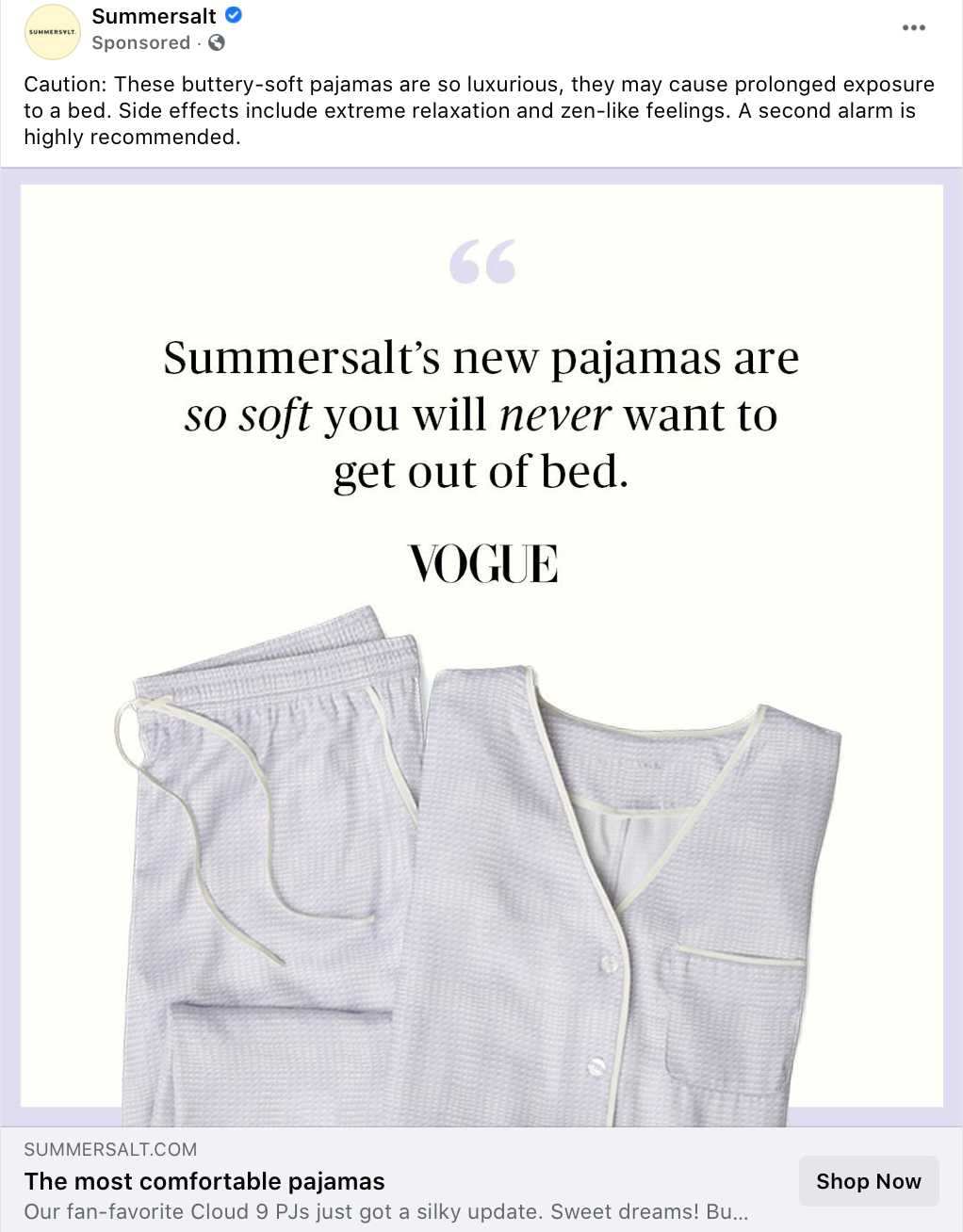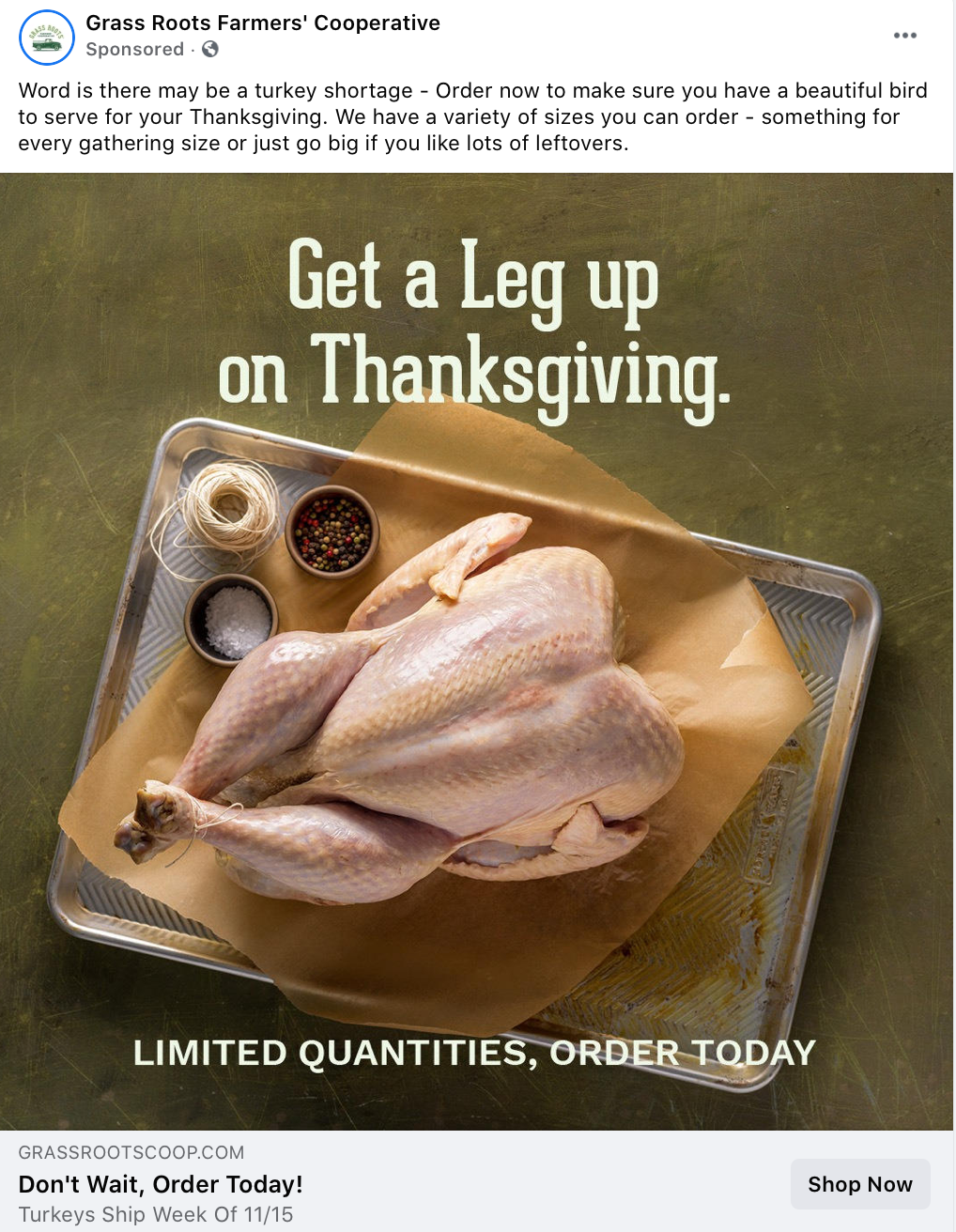Facebook is a powerhouse customer acquisition platform for companies of all sizes. But in order to get great results from your Facebook ads, you need to have great ad copy. And in my experience, that’s where lots of brands struggle.
I’ve been writing social pay-per-click (PPC) copy for Facebook ads and other platforms for almost a decade. While your ad strategy needs to be tailored to your audience and your strongest selling points, there are 12 solid copywriting strategies that I use time and time again to help my clients get results. Let’s take a look at each.
12 Facebook ad strategies to test for your business
Each of these Facebook ad copy strategies can be adapted across industries, so consider them a jumping-off point for putting your own spin on things.
1. State a problem and offer a solution
This strategy is all about showing the customer that you understand their problem—and can solve it. They can relate to the ad, and they’re immediately drawn in to see the solution. Here’s an example:

In this ad, the problem is posed as a question (“How many nursing covers can you wear when you’re not even nursing?”), and it attracts nursing mothers who haven’t been able to find a fashionable nursing cover. Then they introduce their product (“Meet the Cocoon”) before explaining more about what it is.
It’s an effective ad because it appeals strongly and quickly to a specific pain point.
2. Get creative
There’s a fine line between creative and gimmicky. But if you can walk the right side of that line, you’ll grab your audience’s attention.
One example is “going negative.” You do this by presenting the brand’s positive strengths as a negative in a joking way to drive that unique selling point home. Think: “Warning: Our clothes last so long, you’ll never have to shop again.” Summersalt does this well, starting with a jolting “Caution:” and proceeding to talk about how the “buttery-soft pajamas are so luxurious” that they make you want to never leave your bed. Funny and effective, without being over the top.

3. Use social proof
Social proof goes a long way, and you can use popularity-focused terms like “fastest-selling,” “highest-rated,” or “award-winning” to mimic that vibe in a Facebook ad. Bring up the thousands of 5-star customer reviews you have. Share text pulled directly from a well-written customer review or a user-generated image. Showcase a review of your brand in an esteemed source or publication. You’re using social proof to build trust and leverage a little bit of FOMO.
Here’s a great example from Formula. They mention their happy customers and incorporate UGC into the video with text overlay.

4. Set the vibe with descriptive language
While online retail and advertising open up all sorts of possibilities, they do have one drawback: your customers can only use their hearing and sight to evaluate your products. You can’t exactly add one of those scratch-and-sniff perfume samples to your Facebook ad like you can with a print ad. So, when you have a product that heavily relies on smell, taste, or feel, you need to make up for it with the language you use.
Let’s look at this example from Pure Instinct.

Scents are difficult to describe and a little subjective, so a perfume company like Pure Instinct has to be on its writing game. This ad for its LUCKY scent uses adjectives like “fresh,” “bright,” “fruity,” and “floral” to evoke the same sensation as the scent. Every word in the ad paints a picture of how the perfume will make you smell and feel.
5. Try feature-benefit selling
Feature-benefit selling is one of the oldest tricks in the sales book. I learned it when I was a salesperson at a jewelry store, and I heard it recently when I bought a new car.
Here’s how it works. You state a feature (“the car has lane assist technology that keeps your car in the lines”), and then immediately explain how that feature benefits the customer (“you’ll never risk drifting out of the lane and into another car”).
This strategy will be most effective when the benefits are tailored to individual customer segments and their needs, motivations, and pain points. For example, if you were talking to parents, you might say, “You won’t drift out of the lane when you have to turn around to check on the kids.” But since I have three dogs, the salesperson said, “when your dog crawls into your lap.”
Here’s an example of how this might work on Facebook, embedded into a UGC post.

The review mentions “panels sewn inside of the pants” as the feature; the benefit is the “amazing shape… it’s like wearing shapewear without the extra steps.”
This is more effective than just stating features, which can fall flat, and it’s more effective than just stating benefits because it explains how you can achieve these benefits, which builds trust.
6. Go seasonal
Running timely, season-specific Facebook ads ensures your content is relevant to users right now.
Remember: you can position your product or service as seasonal even if it’s also evergreen. A simple example would be an eCommerce company selling organic knits and throws. Come Mother’s Day, they promote the knits as being an essential part of a “care kit” for moms to enjoy their day in comfort. During the winter holidays, the throws can be advertised as the perfect gift to keep you warm around the fireplace. And so on.
Seasonality can also help you reach high-intent audiences with gift suggestions. If you do this, use the timeliness to promote urgency, since folks only have a certain amount of time before the holiday passes. Here’s an example.

In this ad, Grass Roots Farmers’ Cooperative talked about how there might be a turkey shortage (topical) and how you should order now (urgency) to make sure that you have a turkey for your family’s Thanksgiving (seasonal). It hits all the right notes—at the right time.
7. Leverage urgency
Holidays aren’t the only time to leverage urgency. You can mention that you’re only offering a sale or coupon code for a limited time. Or maybe you’re only releasing a certain number of bundles that contain high-value products. And if it’s true, you can mention that your items sell out fast. Urgency hits an impulse button that makes folks more likely to purchase quickly, so they don’t keep scrolling, forget about you, and then never come back.
Here’s a great example. Caraway’s ad focuses entirely on urgency, saying that as soon as a product line is dropped, it sells out instantly. “Get your bakeware while supplies last” with the eyes emoji is a powerful CTA.

8. A/B test the same copy with different products
If you have two similar ideas you think are worth trying but aren’t sure which to run, it’s time to A/B test. You might know of this tactic for email marketing, but it works for online advertising, too. Meta Ads Manager even has a built-in feature for it.
The key with A/B testing is to stick to one change between your two versions. Let’s see how this works in these Fly By Jing ads.


Notice how the copy for both ads is identical except for the product mentioned in them. By sticking to one change, Fly By Jing can now see if customers show more interest in the Shorty Spice Set or Chengdu Crunch.
If you want to try Fly By Jing’s product-based A/B test, find two products with similarities that help you stay specific in your ad copy. The Shorty Spice Set and Chendgu crunch have similar uses, for example, so Fly By Jing can have the same food recommendations in both ads.
9. Opt for long-form storytelling
Most ads focus on brevity. That’s the right way to go most of the time, but it’s absolutely worth testing long-form storytelling with the following:
-
Your brand’s story
-
Your personal story as a business owner
-
An in-depth customer story
-
Detailed information about the customer experience
Stories resonate with customers and stick with people on an emotional level. This can make them powerful brand awareness tools—and equally as powerful selling tools. Make sure to start off with a strong hook to get people to click Read more, and choose a great image to pair with it.
Here’s an example from another Zapier article about using your personal story in brand marketing.

The ad tells the story of how Cooper’s Treats created high-quality products with a single question in mind: what would you want your dogs to say to you after they eat the treats you give them? That hooks the reader, and the ad then talks more about the company’s backstory and what’s in the treats themselves.
10. Keep it simple
If your product is heavily visual and the image speaks for itself, keep the accompanying text as simple as possible. But remember, simple doesn’t mean phoning it in. It means choosing your words wisely to keep things concise while still speaking to your audience.
In the example below, Thursday Boot Company has an image-heavy ad showing multiple products. They use the text “Comfortable, Versatile, & Durable” with two emoji at the end. With just three words, they address some of the biggest concerns people have when purchasing, aside from the look of boots (which the image takes care of).

11. Offer a deal
Deals and offers are a copywriter’s dream, and ads are a great place to shout them out. When the customer feels like now is the time to purchase and their risk is low, they’re more likely to follow through.
Italic does this well: they use feature-benefit selling and then go in with the coupon code. Because a deal in itself isn’t enough—you need to get people to want your product too.

12. Know what your audience wants
Stumped on what to write? Go back to your audience research and sum up what your audience wants in a few words, then use those words in your ad. Keep an eye out for values you can appeal to in your copy.
Take this ad from Maggie’s Sewing & Vacuum as an example.

The ad copy stresses that the business is local, family-owned, and experienced. Maggie’s Sewing & Vacuum clearly plans to draw in customers who want to work with a business they can trust like a neighbor. And considering the business works with expensive equipment, it’s a good bet its audience will appreciate that notion (no sewing pun intended).
Automate your Facebook ad workflows
Whichever strategy you use, remember to look at the numbers. Even once you find an ad that drives results, you can continue to test different versions of the copy, maybe adjusting the formatting, the word choice, or the accompanying image. Over time, you’ll be able to see clear patterns and develop a custom-for-your-brand copywriting strategy that works for you.
To have more time to focus on the creative copy, you can put your Facebook ad campaigns on autopilot with Zapier’s Facebook Lead Ads, Facebook Custom Audiences, Facebook Offline Conversions, and Facebook Conversions integrations. Read our guide to Facebook automation, or get started with one of these pre-built workflows.
Zapier is the leader in workflow automation—integrating with 6,000+ apps from partners like Google, Salesforce, and Microsoft. Use interfaces, data tables, and logic to build secure, automated systems for your business-critical workflows across your organization’s technology stack. Learn more.
Related reading:
This article was originally published in November 2021. The most recent update, with contributions from Melissa King, was in May 2024.